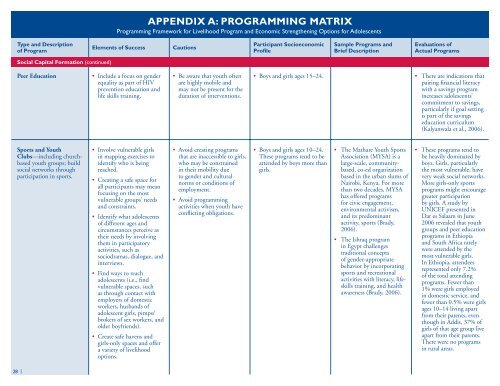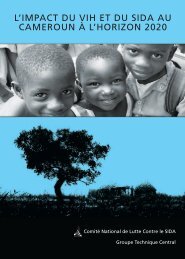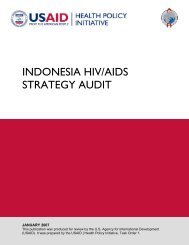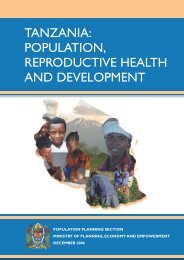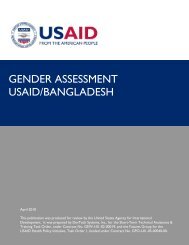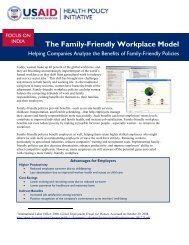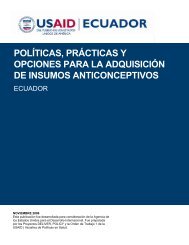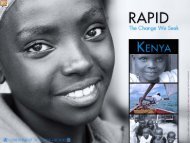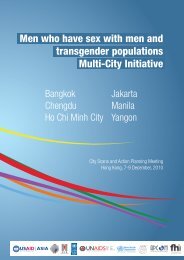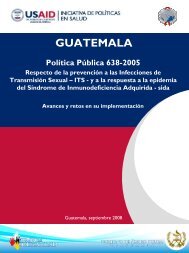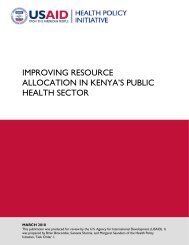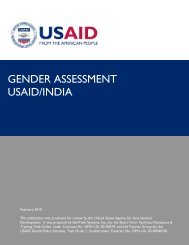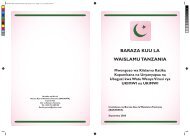APPENDIX A: PROGRAMMING MATRIXProgramming Framework for Livelihood Program and Economic Strengthening Options for Adolescents 1Type and Descriptionof ProgramElements of SuccessCautionsParticipant SocioeconomicProfile2Sample Programs and3Brief DescriptionEvaluations ofActual ProgramsSocial Capital Formation (continued)Peer Education• Include a focus on genderequality as part of HIVprevention education andlife skills training.• Be aware that youth oftenare highly mobile andmay not be present for theduration of interventions.• Boys and girls ages 15–24.• There are indications thatpairing financial literacywith a savings programincreases adolescents’commitment to savings,particularly if goal settingis part of the savingseducation curriculum(Kalyanwala et al., 2006).Sports and YouthClubs—including churchbasedyouth groups; buildsocial networks throughparticipation in sports.• Involve vulnerable girlsin mapping exercises toidentify who is beingreached.• Creating a safe space forall participants may meanfocusing on the mostvulnerable groups’ needsand constraints.• Identify what adolescentsof different ages andcircumstances perceive astheir needs by involvingthem in participatoryactivities, such associodramas, dialogue, andinterviews.• Find ways to reachadolescents (i.e., findvulnerable spaces, suchas through contact withemployers of domesticworkers, husbands ofadolescent girls, pimps/brokers of sex workers, andolder boyfriends).• Create safe havens andgirls-only spaces and offera variety of livelihoodoptions.• Avoid creating programsthat are inaccessible to girls,who may be constrainedin their mobility dueto gender and culturalnorms or conditions ofemployment.• Avoid programmingactivities when youth haveconflicting obligations.• Boys and girls ages 10–24.These programs tend to beattended by boys more thangirls.• The Mathare Youth SportsAssociation (MYSA) is alarge-scale, communitybased,co-ed organizationbased in the urban slums ofNairobi, Kenya. For morethan two decades, MYSAhas offered programsfor civic engagement,environmental activism,and its predominantactivity, sports (Brady,2006).• The Ishraq programin Egypt challengestraditional conceptsof gender-appropriatebehavior by incorporatingsports and recreationalactivities with literacy, lifeskillstraining, and healthawareness (Brady, 2006).• These programs tend tobe heavily dominated byboys. Girls, particularlythe most vulnerable, havevery weak social networks.More girls-only sportsprograms might encouragegreater participationby girls. A study byUNICEF presented inDar es Salaam in June2006 revealed that youthgroups and peer educationprograms in Ethiopiaand South Africa rarelywere attended by themost vulnerable girls.In Ethiopia, attendeesrepresented only 7.2%of the total attendingprograms. Fewer than1% were girls employedin domestic service, andfewer than 0.5% were girlsages 10–14 living apartfrom their parents, eventhough in Addis, 37% ofgirls of that age group liveapart from their parents.There were no programsin rural areas.28 |
REFERENCESAdato, Michelle, and John Hoddinott. 2007. Conditional Cash Brady, Martha. 2006. “Leveling the Playing Field: BuildingTransfer Programs: A “Magic Bullet” for Reducing Poverty? 2020 Girls’ Sports Programs in the Developing World.” PromotingFOCUS BRIEF on the World’s Poor and Hungry People. <strong>Health</strong>y, Safe, and Productive Transitions to Adulthood, Brief 1.Washington, DC: International Food <strong>Policy</strong> Research Institute New York: Population Council.(IFPRI).Bruce, Judith. 2006. A Note on the Social and EconomicAcademy for Educational Development (AED). 2008.Development and Reproductive <strong>Health</strong> of Vulnerable Adolescent“Economic Strengthening for Vulnerable Children: Principles Girls. Florence: United Nations Children’s Fund (UNICEF)of Program Design and Technical Recommendations for Innocenti Research Center.Effective Field Interventions.” FIELD Brief No. 3. Washington,DC: AED, Save the Children, USAID.Bruce, Judith, and Amy Joyce, eds. 2006. “The Girls LeftBehind: The Failed Reach of Current Schooling, Child <strong>Health</strong>,Alam, Aminul. No date. Innovative Ways of Reaching and Youth-serving, and Livelihoods Programs for Girls Living in theBenefiting the Most Poor and Most Vulnerable People. Dhaka: Path of HIV.” New York: Population Council.BRAC.Bruce, Judith, and Kelly Hallman. 2008. “Reaching the GirlsAmbler, John. 2002. The Program Strategy Paper: A Tool for Left Behind.” Gender and Development 16(2): 227–245.Integrating CARE’s Household Livelihood Security and Rights-Based Approaches within a Program Structure. Atlanta, GA: Bundred, Frances, Jared Penner, and Pauline Achola. 2007.CARE.“Responding to HIV/AIDS within MFIs in Mozambique:Lessons Learned from an Action Research Project.”Amin, Sajeda. 2008. “Enhancing the Benefits of Girls’MicroREPORT # 80. Washington, DC: ECIAfrica ConsultingLivelihood <strong>Initiative</strong>s.” Promoting <strong>Health</strong>y, Safe, and Productive (Pty) Ltd., Mennonite Economic Development Associates.Transitions to Adulthood, Brief No. 17. New York: PopulationCouncil. Bundred, Frances, Jared Penner, and Pauline Achola. 2006.“Responding to HIV/AIDS within MFIs in Mozambique:Amin, Sajeda. 2007. “Empowering Adolescent Girls in Rural Lessons Learned from an Action Research Project.”Bangladesh: Kishori Abhijan.” Promoting <strong>Health</strong>y, Safe and MicroREPORT #80. Washington, DC: USAID.Productive Transitions to Adulthood, Brief No. 13. New York:Population Council.“Butterflies Project: Indian NGO Working with StreetChildren, Empowering Them to Define Their Own NeedsBari, Zain. 2005. “Experimenting with New Ideas: IDF and and Priorities.” 2004. Article 13. London: Corporate SocialPadakhep.” Grameen Dialogue, Issue 60. Dhaka: The Grameen Responsibility.Trust.Caldwell, Richard. “Essentials of Project Design: Extract fromBarnes, Carolyn. 2003. Microfinance and Households: Coping the Project Design Handbook: A Working Draft.” Atlanta, GA:with HIV/AIDS in Zimbabwe: An Exploratory Study. New York: CARE, TANGO International.Population Council.Camfed International. 2006. “Building the Capacity of YoungBidwell, Kelly, Colleen Galbraith, Linda Haddad, Rachel Rural Women: The Cama Seed Money Scheme.” Cambridge:Hermes, Sarah Kleiner, Zaki Raheem, and Kenneth Scheffler. Camfed International.2008. Market Assessment Toolkit for Vocational Training Providersand Youth: Linking Vocational Training Programs to Market Camfed International. 2004. “Camfed International: AnOpportunities. New York: Women’s Commission for Refugee Overview.” Media Information, November 11. Cambridge:Women and Children.Camfed International.Bonnell, Christopher, James Hargreaves, Vicki Strange,Paul Pronyk, and John Porter. 2006. “Should StructuralInterventions be Evaluated Using RCTs? The Case of HIVPrevention.” Social Science & Medicine 63(5): 1135–1142.Cardoso, Eliana, and André Portela Souza. 2003. “The Impactof Cash Transfers on Child Labor and School Attendance inBrazil.” Working Paper. Nashville, TN: Vanderbilt University,Department of Economics.BRAC. 2008. “Youth Financial Services: The Case of BRAC &the Adolescent Girls in Bangladesh.” Dhaka: BRAC.29 | <strong>LIVELIHOOD</strong> <strong>OPTIONS</strong> <strong>FOR</strong> <strong>GIRLS</strong>: A GUIDE <strong>FOR</strong> PROGRAM MANAGERS


